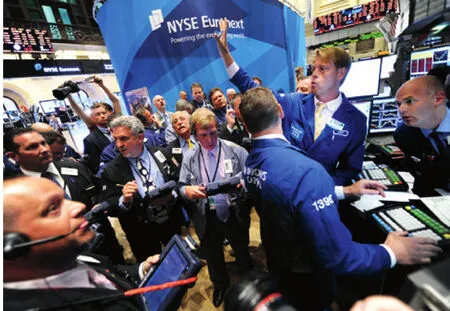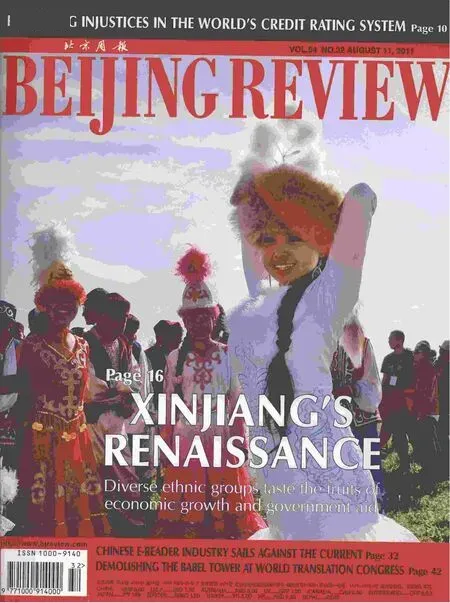Angels or Demons
2011-10-14ByWEILIANG
By WEI LIANG
Angels or Demons
By WEI LIANG
The roles and motives of the big three rating agencies need to be reconsidered
Following the global financial crisis in 2008, rating agencies Moody’s, Standard & Poor’s and Fitch Ratings came under the limelight. They were deeply implicated in the sub-prime mortgage crisis—high ratings of many risky sub-prime debts blinded investors, touching off the crisis. In recent years, they have lowered the ratings of debts in PIGS countries—Portugal, Ireland, Greece and Spain—and threatened to throw more European debts into the “junk” pile.
The alarms they sounded not only have hidden the real problems behind the global financial crisis, but also are hindering efforts to alleviate the euro-zone sovereign debt crisis. So it all begs the question: Are rating agencies more angelic or demonic in nature? Either way, their behavior need to be reconsidered.
Angels at first
Credit rating is nothing new. The three credit rating agencies in question all have century-old histories. Credit rating, in a modern sense, started in the United States in the early 20th century when companies with various fnancial backgrounds began to issue bonds to build railways to make money.
But because corporate information was opaque and companies’ finances and credit were not completely open and available for analysis, defaults on debts were hard to avoid, creating a major headache for investors.
In 1909, John Moody, the founder of the Moody’s rating agency, sensed a business opportunity in the making. He published a manual on U.S. railway investment. Since this was the first rating of bonds issued by various railway companies, Moody’s venture was instantly successful.
In the early years of the 20th century, the U.S. economy boomed, so financial problems were few, leaving rating companies with little to disclose. This allowed them to fall to the wayside of public concern.
The Great Depression struck in the 1930s, causing numerous companies to go bankrupt leaving their debts unpaid. Thenpeople found out those companies had been given low ratings by credit rating agencies—it should have been no surprise that the companies went under. Since then, credit rating has been regarded as an important standard by bond investors, allowing credit rating agencies to establish their reputations as guardians of investors.
Not that virtuous
Rating agencies make money by selling rating reports, particularly in times of economic turmoil. They face financial diffculties when the economy booms because rating information is irrelevant when investment opportunities are abundant and risks are low.
Growth counter to economic cycles is an important reason for considering these agencies to be more sinister than altruistic.
First, countercyclical growth of rating agencies helped change pricing methods. Before the 1970s, revenue streams for rating agencies mainly came from rating reports purchased by bond investors. When the economy entered an expansion phase, however, these investors would not buy their reports. But rating agencies also found that whether the economy was good or bad, bond issuers were always in favor of fair ratings. In the early 1970s, rating agencies changed their way of charging, releasing free reports to readers while charging bond issuers to make ratings.
The downside of this new pattern is a dilemma in deciding which user base to be loyal to: bond issuers who pay or readers who don’t. The massive high-rating subprime mortgages during the sub-prime crisis prove that sometimes rating agencies are obviously loyal to those who pay.
Second, countercyclical growth of rating agencies promotes countercyclical growth of goodwill and trust. The long history of rating agencies must be attributed to the accuracy of ratings. In other words, if rating agencies make too many inaccurate ratings, their reputation will be tarnished.
When the economy goes up, rating agencies will raise the ratings. Since most debts can be paid back, high ratings cost them nothing but bring them more goodwill and profts. When the economy goes down, lower ratings will be safer, because bonds are more likely to go unpaid. If rating agencies markedly lower ratings of some companies in peril, they can also gain massive goodwill.
For example, in the current EU debt crisis, default risks in PIGS countries are obviously high. Moody’s, Standard & Poor’s and Fitch Ratings are repeating this commonly recognized fact in an authoritative tone, pretending to be sharp-eyed and wonderfully foresighted. Their intentions may not be to completely sink the PIGS countries and spread the debt crisis, but at least by repeating commonly recognized facts, they can raise their reputations.
Rating agencies are also weathervanes—they will swiftly readjust their ratings when the economic trend changes to go along with the situation to maintain their reputation.
Third, rating agencies are favored by the U.S. Government. In 1975, the U.S. Securities and Exchange Commission (SEC) established an access mechanism for “nationally recognized statistical rating organizations,” and in the following two decades, Moody’s, Standard & Poor’s and Fitch Ratings gradually monopolized the rating market in the United States. Despite rating agencies’ involvement in the 2001 Enron scandal—which led to the bankruptcy of U.S. energy company Enron Corp. and the collapse of auditing and accountancy firm Arthur Andersen—and the adoptionof the 2006 Credit Rating Agency Reform Act, the SEC is still conspiring with the three major rating agencies and covertly maintaining a high market concentration. Because of this, people are apt to question how close the relationship between the three rating agencies and the U.S. Government is, whether there are any special purpose in the ratings of other countries and companies, and whether the U.S. Government has a hand in granting ratings.

MARKET IMPACT: Traders at the New York Stock Exchange on June 1, the day major U.S. stock indexes fell sharply following Moody’s lowering of Greece’s sovereign credit rating
Thorny road
Whether rating agencies are angels or demons, their part in the European debt crisis is a forewarning to the hazards of their involvement. True, the countries in crisis are debt-ridden, but when the euro zone and even private creditors are working together to rescue the PIGS, rating agencies still issue warnings for investors to look elsewhere. This is unacceptable. Encouragement should be shown toward EU offcials who want to establish their own rating agencies while forcing the three rating agencies to publish their data sources and rating models.
Besides Europe, China and Russia have also established their own rating agencies—but can they challenge Moody’s, Standard & Poor’s and Fitch Ratings?
Alternative agencies do not have the reputations or experience of the established institutions. Older, generally means better in terms of goodwill and, more importantly, trust. Without trust, how can bond issuers be expected to believe a rating agency’s data?
Also, the more impartial new rating agencies are, the more they are likely to be driven out of the market. Since bond issuers pay, they want praise, not criticism from reports. New rating agencies won’t be willing to do this and will suffer from it.
Rating models and data sources are trade secrets, and when these factors are secret, people could only rely on their intuition to make judgments, so the impartiality of new rating agencies will be hard to prove. Therefore, before there is clear worldwide supervision on credit ratings, especially those of sovereign debts, the infuence of Moody’s, Standard & Poor’s and Fitch Ratings can hardly be replaced.
Ultimately, the world needs emerging rating agencies and global supervision rules to restrain the sinister side of the big three rating agencies.
The author is an assistant research fellow with the Institute of World Economic Studies at the China Institutes of Contemporary International Relations

XINHUA/AFP
